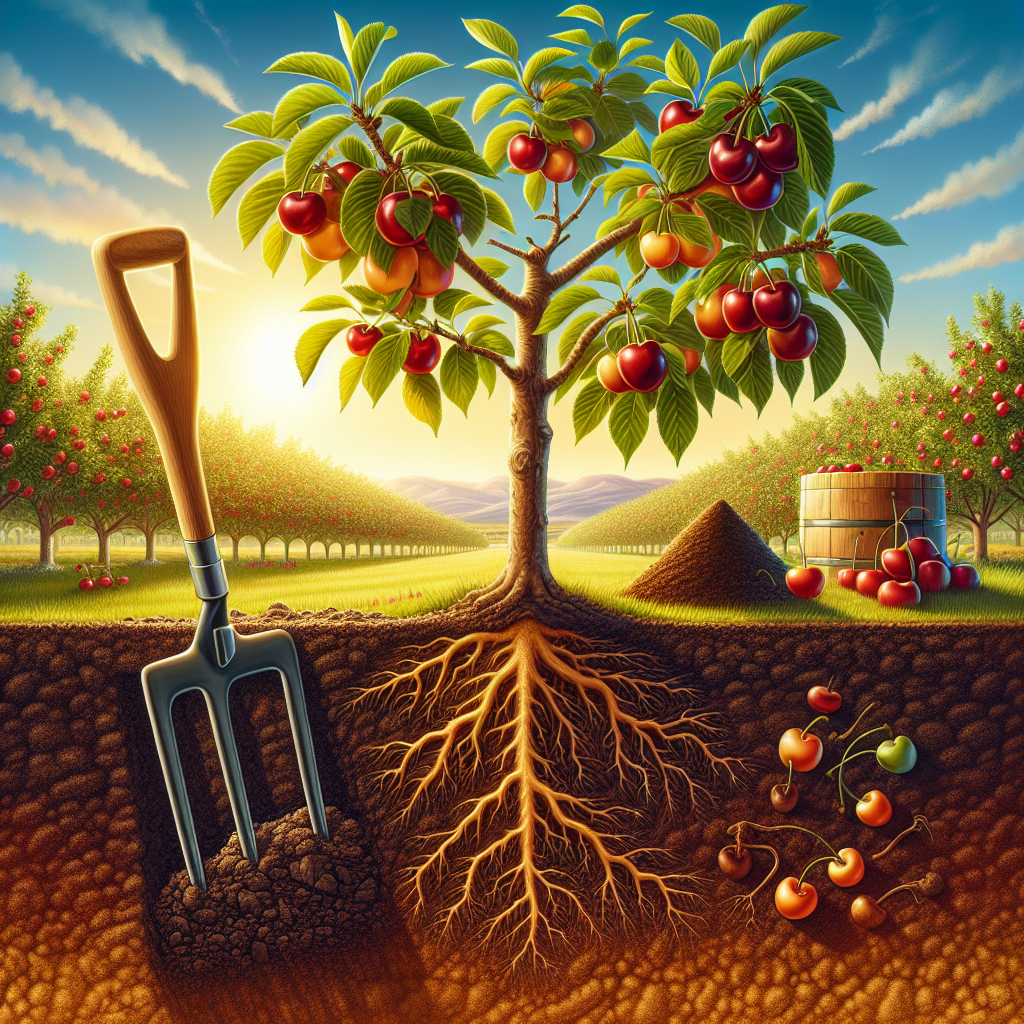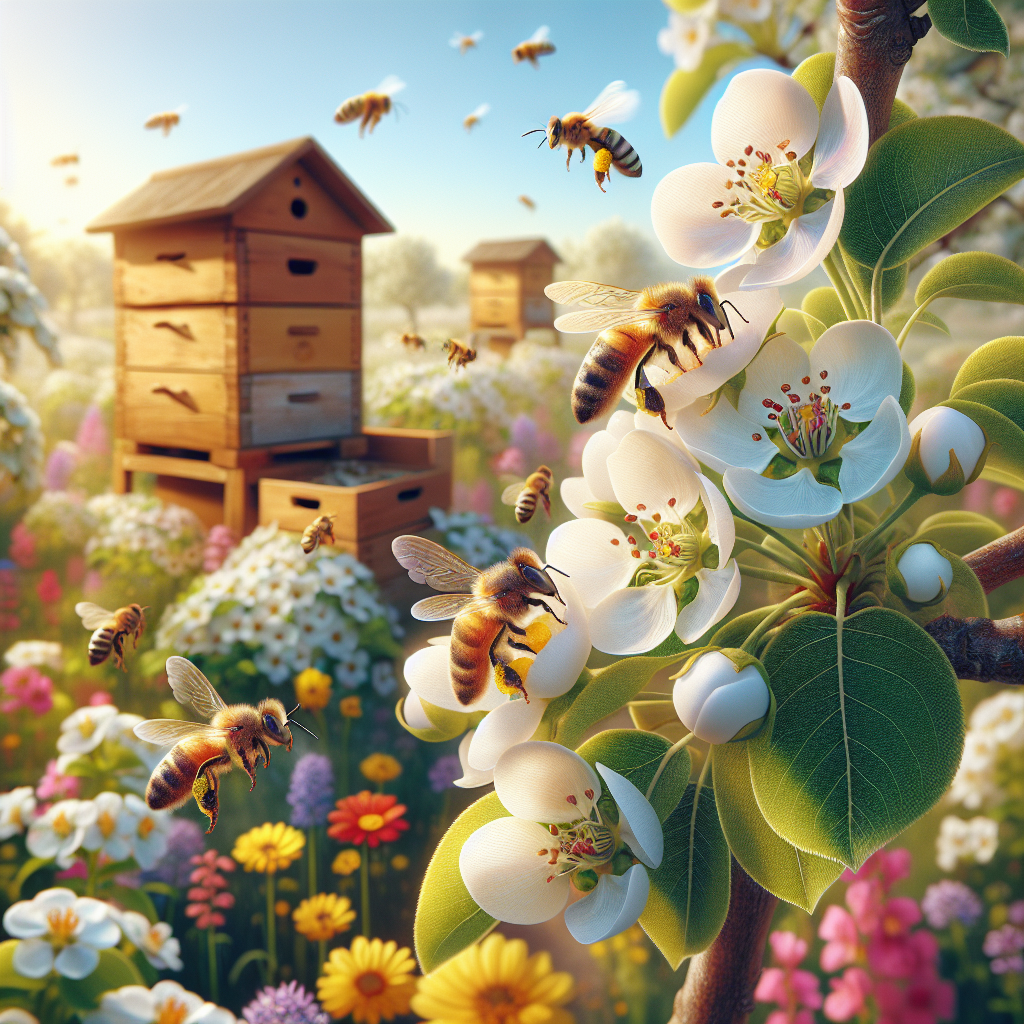Managing Soil Health for Cherry Trees
Published January 13, 2024 at 6:33 pm

Understanding the Pillars of Soil Health for Cherry Trees
- Pet Friendly: Cherry trees are generally safe for pets, but keep in mind that the seeds, leaves, and stems can contain cyanide which is toxic.
- Light Requirements: Cherry trees require full sun to produce the best fruit, meaning at least six to eight hours of sunlight daily.
- Watering: Consistent watering is vital for young cherry trees, especially during dry spells, though mature trees can tolerate some drought.
- Humidity: Cherry trees do not have specific humidity requirements but they don’t fare well in overly humid environments which can foster fungal diseases.
- Temperature: Cherry trees need cold winter temperatures to set buds but can be damaged by late spring frosts.
- Difficulty: With proper knowledge about soil requirements, pest control, and pruning, growing cherry trees can be manageable, even for less experienced gardeners.
When it comes to cultivating luscious cherry trees, managing soil health is critical. These fruit-bearing beauties thrive in well-drained, fertile soils enriched with organic matter. But before you start amending your garden’s soil, you need to understand the key elements that contribute to the overall health of the soil and, by extension, the cherry trees.
Conducting Soil Tests: The First Step in Soil Management
One of the most effective ways to assess your soil’s health is through regular soil testing. By doing so, you can gain valuable insights into the pH level, nutrient content, and presence of any toxic substances that could harm your cherry trees. Most Cooperative Extension Services offer soil testing for a nominal fee, providing you with a detailed analysis and recommendations.
Soil pH is particularly crucial for cherry trees. They prefer a slightly acidic to neutral soil, with a pH between 6.0 and 7.0. If your soil is too alkaline, you might consider adding sulfur to lower the pH. Conversely, if it’s too acidic, applying lime can help balance it out. Remember, though, these amendments take time to work, so plan ahead.
Selecting the Right Fertilizers
Fertilizing is an integral part of maintaining fruitful cherry trees, but it’s not just about dumping any fertilizer at the base of your tree. Cherry trees benefit from specific nutrients like nitrogen, phosphorus, and potassium, which can be supplied through organic or inorganic fertilizers. Slow-release fertilizers are often recommended because they provide a steady supply of nutrients over time.
Dr. Earth Organic Fruit Tree Fertilizer emerges as a well-trusted product. Formulated with probiotics and mycorrhizae, it’s said to enhance root development and improve nutrient uptake. Reviewers often applaud this fertilizer for how it boosts fruit production and improves tree vigor—all without relying on synthetic chemicals.
Find This and More on Amazon
Utilizing Organic Matter: Compost and Mulch
Another cornerstone of soil health is organic matter. Compost, rich in nutrients, is as nourishing for the soil as home cooking is for the family. It enhances the soil structure, fosters microbial life, and boosts the soil’s water-holding capacity. Layering compost around the base of your cherry trees can significantly improve soil quality over time.
Mulching is equally beneficial. It conserves moisture, regulates soil temperature, and can suppress weeds. Organic mulches like wood chips or straw break down gradually, contributing to soil fertility. However, be sure not to pile mulch up against the trunk to avoid rot and pest issues. A ring that extends several feet from the trunk, starting a few inches away from the bark, is ideal.
Watering Strategies: Beyond the Roots
If you might be wondering about watering, know that cherry trees like their soil moist but not waterlogged. Overwatering can deprive roots of oxygen and promote root rot, so use a moisture meter or check the soil manually to gauge when to water. During the growing and fruiting seasons, a deep watering once a week is often sufficient.
Drip irrigation systems can be a gardener’s best ally, providing slow, steady hydration directly to the root zone while minimizing water waste. A system like the Rain Bird Drip Irrigation Kit is frequently mentioned in garden circles for its efficiency and ease of installation. Reviews frequently praise this system for its effectiveness in maintaining ideal moisture levels for cherry trees without overwatering.
Find This and More on Amazon
Recognizing and Tackling Soil-Borne Diseases
Even with the best care, soil-borne diseases like Phytophthora root rot can strike. This fungus thrives in wet, poorly drained soil and can be devastating. Symptoms include yellowing leaves, poor growth, and branch dieback. Improving soil drainage can help, as well as using resistant rootstocks when planting new trees.
For instance, the Gisela 5 rootstock is popular among cherry tree growers for its resistance to common soil pathogens. Garden forums often highlight its performance in both commercial orchards and backyard gardens. Consistently positive reviews indicate its reliability in preventing diseases while ensuring abundant cherry yields.
Find This and More on Amazon
Implementing Integrated Pest Management (IPM)
When you’re growing cherry trees, pests can be a real headache. Implementing an Integrated Pest Management (IPM) plan, which combines cultural, biological, and chemical methods, can effectively manage pests while minimizing harm to the environment. For instance, encouraging beneficial insects that feed on common cherry tree pests can be a natural way to protect your trees.
Chemical treatments should be considered carefully, based on the specific pest and severity of the infestation. Products such as Neem Oil are favored in organic gardening circles, known for their ability to deter pests like aphids and mites without harsh chemicals. Reviewers often note how Neem Oil, when used correctly, has helped control pests without negatively affecting beneficial insect populations.
Cultivating the Right Microbial Community
Soil isn’t just dirt; it’s a living ecosystem teeming with beneficial microbes. These tiny organisms play a crucial role in breaking down organic matter, nutrient cycling, and even protecting plant roots from pathogens. Adding organic matter and using products like Mycorrhizal Fungi Inoculant can encourage a healthy microbial community. According to the chatter in gardening forums, this inoculant can dramatically improve plant health, supporting strong root development and increased nutrient uptake.
Using cover crops during the off-season can also boost soil health by adding organic matter, preventing erosion, and enhancing soil structure. Options such as crimson clover or annual ryegrass are popular among cherry tree farmers for these benefits.
Navigating the Seasons: Seasonal Soil Care for Cherry Trees
As seasons change, so do the needs of your soil and cherry trees. In spring, applying a balanced fertilizer can kickstart growth. Summer calls for monitoring water levels and pest activity. Come fall, it’s time to test the soil and add amendments, if necessary. Winter is ideal for pruning and planning for the next growing cycle.
Many gardeners swear by the use of a good pruning saw, like the Silky Gomboy Professional, when it comes to winter care. Its sharp blades and ergonomic handle make for clean cuts that promote healthy tree growth. Reviews often mention how this tool has made pruning tasks much less of a chore and helped maintain cherry tree health through the cold months.
Optimizing Irrigation Techniques for Cherry Trees
Drip or trickle irrigation systems are favored among cherry tree growers for their ability to provide precise water delivery. This reduces the chances of over-irrigation and conserves water by delivering it right where it’s needed.
Imagine strolling through your orchard and seeing rows of cherry trees with a well-set-up irrigation system, such as those offered by Raindrip. Their products come highly recommended for allowing precise control over water delivery, thus optimizing irrigation and promoting healthier trees. Gardeners describe their Raindrip systems as game-changers, perfect for keeping soil moisture at ideal levels without wasting a drop.
Treating and Preventing Cherry Tree Pests and Diseases
Cherry trees can be susceptible to a variety of pests and diseases which can stress the tree and compromise fruit quality. Using organic methods to treat and prevent such issues can be effective and environmentally responsible.
An organic approach might involve the application of Monterey LG6135 Garden Insect Spray, a product containing spinosad, a naturally occurring soil bacterium. This spray controls many common pests such as caterpillars, leafminers, and thrips without harming beneficial insects. Many reviewers tout its efficiency, often reporting that it cleared up their infestations after just a few applications.
Proper Pruning Practices
Pruning is not just about shaping your cherry trees; it’s about encouraging healthy growth and fruit production. By selectively cutting away parts of the tree, you can control its size and shape, increase sun and air exposure to the fruit, and remove any dead or diseased limbs.
You might consider a specialized tool like the Felco F-2 Classic Manual Hand Pruner for this task. Gardeners across various forums claim that its sharp, precision blades and comfortable grip make it ideal for precise pruning of cherry trees. This hand pruner’s durability and ease of use are frequently mentioned in glowing reviews.
Year-Round Soil Care for Cherry Trees
Soil management for cherry trees is a year-round commitment. During the dormant winter months, organic mulching and occasional watering on dry sunny days can preserve soil moisture and prevent frost heaving.
As spring arrives, it’s time to replenish nutrients with a top-dressing of compost or a balanced slow-release fertilizer. The application of organic matter should be followed up by summer’s vigilant pest monitoring and proper water management to support the growing season’s demands.
Advanced Techniques: Soil Amendments and Enhancers
Beyond basic care, you might explore advanced soil amendments and enhancers that can provide additional benefits to your cherry trees. Products such as biochar and rock dust can improve soil structure, increase nutrient availability, and encourage beneficial microbial activity.
The use of a high-quality biochar, like the one from Wakefield Biochar, often surfaces in discussions as a superb soil enhancer. Many have shared that adding this product to their orchard soil has led to noticeable improvements in tree health and fruit yield, according to online reviews.
Communities of Practice: Learning from Other Cherry Tree Growers
As you develop your soil management plan for cherry trees, it can be incredibly beneficial to connect with other growers. Online forums, local gardening clubs, and extension service workshops can provide a wealth of knowledge and experience.
By engaging with these communities, you may discover user-endorsed tools such as the Garrett Wade Professional-grade Landscaping Rake. Enthusiasts often rave about its effectiveness for spreading compost and mulch evenly around their trees, making soil preparation simpler and more efficient.
Choosing the Right Soil for Potted Cherry Trees
If you’re growing cherry trees in pots, selecting the right potting mix is essential for maintaining soil health. You need a well-draining mix that retains enough moisture to keep the roots hydrated while preventing waterlogging, which can lead to root rot.
Many recommend using a combination of peat moss, pine bark, and perlite or vermiculite as seen in products like FoxFarm Ocean Forest Potting Soil. Positive reviews mention the balanced pH, nutrient content, and optimal drainage provided by this blend, making it a top choice for potted cherry cultivation.
Maintaining Soil Health in Changing Climates
Climate change presents new challenges for maintaining soil health. With shifting weather patterns and extreme conditions becoming more common, adapting your soil care strategy is crucial to ensure your cherry trees can thrive.
Strategies like increasing organic matter content and improving drainage are key. Additionally, using moisture-retentive products such as water-absorbing crystals or gels can help soils maintain moisture during periods of drought. The Soil Moist Water Storing Crystals are often cited as an effective solution, with reviewers highlighting how they helped maintain soil hydration and support healthy cherry tree growth through dry spells.
Conclusion and Content area 3 of 3
To wrap it up, managing soil health for cherry trees is a comprehensive process that touches on everything from regular soil testing and proper fertilization to organic pest control and seasonal care. Implementing these practices will support your cherry trees’ optimal growth, yield, and longevity. Remember, the effort you put into soil health today will yield sweet rewards in the seasons to come.
For cherry tree enthusiasts looking to delve deeper into their horticultural journey, products and tools reviewed by fellow gardeners can make soil management less daunting and more enjoyable. Just like the community knowledge available through garden clubs and forums, these products provide additional help and assurance that you’re giving your trees the best possible care.
Budget-Friendly Tips for Soil Health Management
Managing soil health does not always have to cause a dent in your wallet. Opting for cost-effective strategies like creating your own compost from kitchen scraps or utilizing local resources for mulching materials can make a big difference.
Most cities offer free mulch made from recycled yard waste, which can be an excellent resource for gardeners. Not only does this help the environment by recycling organic waste, but it also aids in maintaining the moisture and temperature levels in the soil around your cherry trees.
Supporting Soil Health Through Community Engagement
Becoming involved in your local gardening community can be remarkably beneficial for both novice and experienced cherry tree cultivators. By exchanging tips with fellow gardeners or participating in community gardens or tree-planting projects, you might find innovative, cost-effective ways to maintain soil health.
Participation in local seed or plant swaps, for example, is a great way to obtain different organic matter varieties for your soil, often at no cost. Community members are usually eager to share their experiences, tips, and extra materials, which can be invaluable in managing the health of your cherry tree’s soil.
Long-Term Soil Health: Planning for the Future
The commitment to soil health for your cherry trees is an investment in their future—and yours. Thinking long-term about soil management can save you time and resources. Planning a rotation of cover crops or setting up a rainwater collection system for irrigation are both sustainable practices that contribute to soil health over the years.
By instilling these practices now, you safeguard against potential future problems like soil depletion or water scarcity. And remember, the practices you adopt for your cherry trees can often be transferred to other areas of your garden or orchard, compounding the benefits.
Documenting Your Soil Health Management Journey
Finally, keeping records of what works (and what does not) is a brilliant way to streamline the management of your soil’s health. Note the types of amendments you’ve added, the changes in your watering schedule, and document your trees’ responses to different fertilizers or pest control methods.
Tracking and recording these insights can serve as a reference for future care and provide a learning tool to share with others. Through careful observation and meticulous note-taking, you can perfect your approach to soil health for robust and prolific cherry trees.
Summarizing Soil Health Tactics for Thriving Cherry Trees
In conclusion, your dedication to soil health is paramount when aiming for vibrant cherry trees that yield abundant and tasty fruit. By understanding and implementing the deep-rooted principles of soil testing, organic matter utilization, integrated pest management, and proper watering and fertilization techniques, you’re setting a firm foundation.
And while cherry tree care might seem complex, incorporating reviews and tips on trusted products can simplify your gardening journey. Cherry trees are more than just a plant—they can be a passion, a hobby, or even a source of income. With the right approach, they’ll continue to flourish, bringing beauty and bounty to your garden for many years to come. And when in doubt, remember there’s a whole community of cherry tree enthusiasts out there—ready to share insights, swap stories, and support each other in the wonderful world of gardening.
Shop more on Amazon

